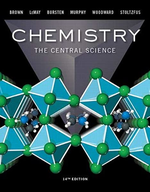?A flask is charged with 0.100 mol of A and allowed to react to form B according to the hypothetical gas-phase reaction \(\mathrm{A}(g) \longrightarrow
Chapter 14, Problem 14.20(choose chapter or problem)
A flask is charged with 0.100 mol of A and allowed to react to form B according to the hypothetical gas-phase reaction \(\mathrm{A}(g) \longrightarrow \mathrm{B}(g)\). The following data are collected:
(a) Calculate the number of moles of B at each time in the table, assuming that A is cleanly converted to B with no intermediates.
(b) Calculate the average rate of disappearance of A for each 40 s interval in units of mol/s.
(c) Which of the following would be needed to calculate the rate in units of concentration per time:
(i) the pressure of the gas at each time,
(ii) the volume of the reaction flask,
(iii) the temperature, or
(iv) the molecular weight of A?
Text Transcription:
A(g) \longrightarrow B(g)
Unfortunately, we don't have that question answered yet. But you can get it answered in just 5 hours by Logging in or Becoming a subscriber.
Becoming a subscriber
Or look for another answer
